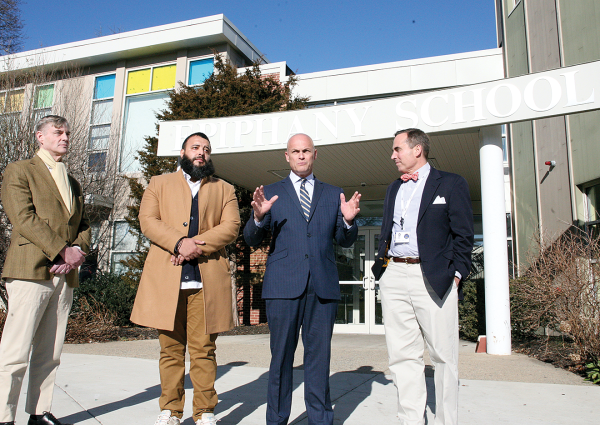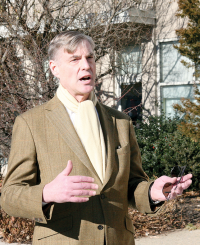January 17, 2024

Andrew Saxe, former Epiphany student Euridio Evora, Damon Seligmon, and Epiphany School Director John Finley outside the school last Friday as they announced the lawsuits. Seth Daniel photo

Led by the Epiphany School, opponents of a planned apartment building next to the Shawmut MBTA station turned to the courts last week in an effort to stymie the project, which won key approvals from city officials last year.
The three lawsuits filed in Suffolk Superior Court on Friday are all aimed at the same target: the 150 Centre St. development, which would replace what is now the Fitzpatrick Brothers Auto Body property with a four-story building with 72 affordable housing units just steps from the Red Line. All the filings name Arthur Jemison, director of the Boston Planning and Development Agency (BPDA), which gave its okay to the project last November, and the principals of Trinity Financial, the development team that controls the site in question.
During a press conference in front of the Epiphany School on Friday morning, the school’s founder and director, Rev. John Finley, a neighbor, Andrew Saxe, and the attorney Damon Seligmon explained their legal actions.
“We’re filing suit today on behalf of the school,” said Seligmon. “The suit will have a request that the decision by the BPDA be annulled, or in the alternative to be remanded back to the BPDA for further review of the project.”
Trinity Financial, through a spokesperson, declined to comment on the filings.
Epiphany School, an abutter of the 150 Centre St. site, wants to buy the Fitzpatrick site and combine it with a parking lot it owns to expand the school and perhaps add teacher housing. It’s a plan that has support from some abutters and nearby neighbors – with more than 1,000 signatures on a petition to that effect.
Epiphany’s legal bid focuses on the 121A designation that Trinity applied for and received for the project. According to the BPDA website, 121A projects are granted to generate economic advancement to areas that are blighted. In return, the city, the BPDA, and the state deliver a “streamlined regulatory process and a negotiated alternative tax payment in lieu of real and personal property taxes.”
Finley said they find fault with the BPDA decision that granted the project under that specific designation.
“Today we’re filing an appeal with the BPDA against [the developer] saying our neighborhood is blighted,” said Finley. “You can see it’s a beautiful neighborhood with a lot of people who really care about it. It’s not accurate and it’s not fair and we want them to go through the full, normal zoning process if they’re really going to go ahead with this.”
Seligmon said the BPDA did not establish the area as one of “blight, one of decay, one of substantially bad conditions. “If you look around, it really isn’t,” he said. “From that determination, the BPDA becomes the all-encompassing permit granting authority. We believe that determination is incorrect. It’s not based on substantial evidence, and we believe a court will agree with us on that.”
Trinity’s 121A filing goes into detail about why they sought the streamlined permitting process, as well as significant breaks on property taxes for a total of 40 years. The text explains that because of rock ledge, and a high water table, a very expensive foundation with waterproofing is needed, making it very expensive. It also spells out how city and state financing would be easier with the 121A designation, and help keep rents lower. Part of getting that designation is showing that the project area is “blighted.”
The second suit, brought by Saxe on behalf of neighbors, focuses on a specific section of the city’s zoning code— Article 65 in the Dorchester Overlay District – and alleges that the requirements for it were ignored.
“There is [an overlay district] here in Dorchester, Article 65, and that means new construction has to be to the scale and size of the surrounding neighborhood,” he said. “The requirements under this article were just ignored by BPDA. One of them was that the proposal has to go to the Boston Landmarks Commission, which was never done. The BPDA did not follow its own rules.”
Trinity, in its 121A filing, addressed the Overlay District matter and noted that the “deviations” from Article 65 are warranted.
“The Applicant believes that these deviations do not substantially derogate from the intent and purposes of the Boston Zoning Code, specifically [the Dorchester Neighborhood Zoning Article], which indicates that the Zoning Commission was intent on seeking to direct growth to areas where it could be accommodated and promoting the development of affordable housing compatible with adjacent areas,” Trinity’s filing states.
The third lawsuit comes from direct abutters to the project on Allston and Centre streets, who claim Adverse Possession, often known as squatter’s rights. They argue that one area of the property line used by Trinity for the project does not follow a fence that has been in place for decades and maintained by neighbors. They seek to prevent Trinity from building beyond the fence, and also have the entire decision annulled.
“Each of those three suits seeks the same relief for separate plaintiffs based on the same record,” said Seligmon.
The 150 Centre St. proposal was the subject of several public meetings and intense debate last spring. Public comment on the matter was split, with opponents arguing that the building is too dense and out of place in a residential neighborhood largely comprising single or smaller multi-family homes and proponents noting that the site— right next to a Red Line subway station— is ideal for so-called “transit-oriented development.”
Trinity downsized its original plan and its 91 units to 72 and lowered the building’s height by one floor. The BPDA board voted 4-0 on Nov. 16 to move the project ahead with Trinity.



